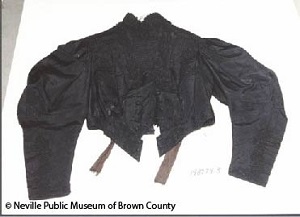From the Education Department: National Lace Day
February 3rd is National Lace Day, and here at
the Neville Public Museum, we have a lot to celebrate.
Lace
was first developed in Europe during the 1500s, and two methods of lace making
formed simultaneously: needle lace (using a single needle and thread) and
bobbin lace (intertwining many threads). Initially, it was made of linen before
transitioning to silk and metallic gold threads. In the 1800s, though, lace makers
turned to cotton, which is what is currently used. During the 16th
century, lace would often be named after the region it was made in. Even though
lace was made all throughout Europe, Italy, France, and Flanders (modern-day
Belgium) established themselves as the leading centers for lace making.
The
finest lace was created by three specialists: an artist who created the
designs, the pattern maker who put the designs onto parchment, and the lace
maker who made the lace itself. All the effort that went into creating the lace
was the reason it was seen as the most treasured, but the creation of all lace was
tedious, which is why it was such a coveted fabric. It adapted with style
through the centuries and, until the 1700s, it was commonly worn by men and
women. Lace was an incredibly popular way to show off one’s high societal
status throughout Europe until the late 18th century because of the
French Revolution.
During
the French Revolution, nobility and royalty would be killed. Not speculating
any farther than their clothing, the seemingly wealthy were beheaded. Once the
revolution was over and all its fighters dead, lace resurged. John Heathcoat
invented a machine for making the most tedious part of lace, the mesh ground,
during the Industrial Revolution. Despite the continual advancements of
technology to create lace, handmade lace was still in demand. Now that
aristocrats and nobility no longer feared for their life, they could return to flaunting
their wealth. As Europeans immigrated to the United States, they brought lacemaking
with them.
Lace
was first introduced in Wisconsin in 1898 by Sybil Carter, an Episcopalian missionary
from Louisiana. Carter taught the Oneida women how to bobbin lace and
established a system sending teachers and materials to several tribes across
the United States, including the Oneida. The finished products were shipped to
New York and went on to win international awards and were sold for high prices.
When Native American children were forced to go to boarding school during the
late 19th and early 20th centuries to assimilate into the
white American culture, they were taught lacemaking. Upon returning home, not
wanting to have to leave their communities again, many Oneida women took up
lacemaking as a career. Therefore, lace goods made by the tribe during this
period may often appear Eurocentric, but they did include many important
symbols to the Oneida, such as the sky dome and the tree of life.
During the Victorian Era, death
was everywhere. Since the Industrial Revolution was happening simultaneously, so
was lace. With death being frequent and romanticized, women would often wear mourning
dresses after losing a loved one, many times including lace. Queen Victoria
herself is most known for this, having worn a mourning dress for 40 years after
losing her husband, Prince Albert. There were various opinions about the social
norms of mourning, especially in the United States: even commonalities between
citizens differed from city to city. When a woman was widowed, the fashion rules
were relatively strict for the two years she would be in mourning. During the
deep mourning phase, a woman would wear plain black clothing and a veil. Should
she wear lace in this stage, it had to be dull and black. Throughout mourning,
a woman may wear this type of lace, and it was acceptable to wear lace mourning
gloves in the later stages of mourning (first and second mourning). Lace would not
be a main fabric worn until the final stage of mourning, known as
half-mourning. Then, a widow would often wear a black lace bonnet with flowers
on it.
During the 1920s, lace was especially popular on tea length
flapper dresses, but, once the Great Depression started, most people could no
longer afford lace, but that did not stop them from recreating the style. Using
gingham fabric, cheap thread, and simple embroidery techniques, women developed
Depression Lace that they would add to make other fabrics more appealing. Real
lace was also used when it could be. If a woman had lace before the Depression
started, she would cut it out of outgrown or shabby clothing to be reused.
 |
| A tea length flapper dress trimmed with lace. |
Mar McKenna





Comments
Post a Comment